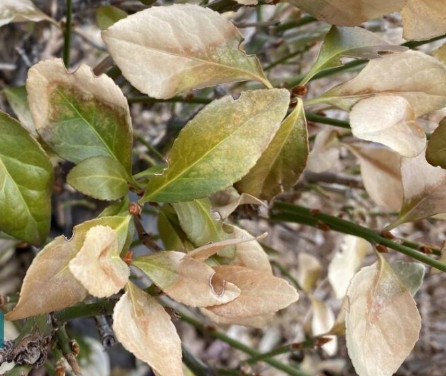Winter Burn on Landscape Plants

The 2024 – 2025 winter season has been unusually windy with long-lasting gusts persisting for hours at a time. As a result of this year’s winter winds, we are going to see “winter burn” on both broadleaf evergreens (e.g. Rhododendrons, Hollies, Boxwoods, Laurels, etc.) and needled evergreens
(e.g. Arborvitae, Cypress, etc.). In most cases, winter burns only cause superficial damage that looks unattractive for a temporary portion of the year.
Winter burn on broadleaf evergreens happens when strong winter wind pulls water vapor from the leaves (the process called desiccation) faster than the leaves can rehydrate. The ground is frozen so roots cannot restore water to leaves that need it. As a result, the outer leaves on these plants dry out and turn various shades of brown in the early spring. By mid-spring, many of the winter-burned leaves will start to shed, either before or during the development of new growth. It may take until early summer to see notable recovery. Ultimately, the timeframe for recovery will depend on the species, and other variables (plant location, age, general health, etc.). Winter burn on needled evergreens mostly shows up as discoloration on these plants. The outer branches of Arborvitae, Cypress, and Cryptomeria turn a yellowy-orange (sometimes brownish) color – called “Bronzing”. It can take as long as a month, to a month-and-a-half, for color to return to these species. Some outer branches might suffer micro-breakage and eventually die. These branches should be pruned off whenever possible.
*IMPORTANT NOTE:
species such as Manhattan Euonymus, Cryptomeria, Various Holly varieties, and Cherry Laurels can look particularly distressed after a tough winter. Some of these plants (especially Manhattan Euonymus) can look dead in late March and fully recover lost growth by July. Nellie Stephens and American Hollies always have a noticeable leaf shed their first spring after planting. This unattractive life cycle can be compounded by the sight of winter-burned leaves clinging to the plant. Allow the plants time to recover and in some cases, give them a little extra care (see recommendation below).
Care and Recovery:
- Prune off outer limbs that are clearly dried out and have no green tissue on the inner stems. If possible, it is best to prune above the closest, live bud (where new growth will emerge). There also might be broken limbs that should be pruned out to promote quicker healing.
- Starting mid-to-late April, fertilize plants every other week with water-based plant food (Miracle-Gro, or equal). Soluble fertilizers do not stay in the soil as long as granular plant food, so feedings should be repeated two to four times during spring. If repeated liquid feedings are not possible, fertilize the plants, once, with a balanced (preferably organic) plant food. Milorginite is an excellent organic product.
- If it is particularly hot or dry in the spring, give winter-damaged plants a little extra water (hose or watering can). For properties with automated irrigation, allow the system to be turned on as early as the irrigation specialist has the opportunity. Follow basic watering principles- MONITOR moisture at ground level a few times a month, and do not wait until the ground is completely DRY to water these plants.
Please contact me with any thoughts or questions, that you have regarding “winter burn” or any landscaping issues you would like to discuss.
Accredited Horticulturist Peter Atkins, (914) 234-0161 and PeterHAtkins62@gmail.com
www.PeterAtkinsandAssociatesllc.com